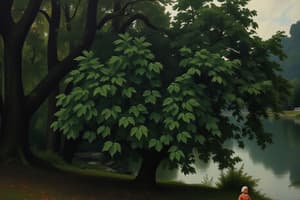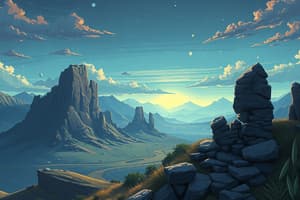Podcast
Questions and Answers
What defines non-fiction literature?
What defines non-fiction literature?
- It recounts fictional stories.
- It is based on true stories and facts. (correct)
- It includes fictional characters and plots.
- It primarily focuses on mythological events.
Which of the following is NOT a type of non-fiction?
Which of the following is NOT a type of non-fiction?
- Biography
- Essays
- Narrative Nonfiction
- Poetry (correct)
What characterizes narrative nonfiction?
What characterizes narrative nonfiction?
- It presents facts in a story format. (correct)
- It focuses on fictional narratives.
- It is purely analytical and avoids storytelling.
- It includes only historical events.
What is the purpose of essays in non-fiction literature?
What is the purpose of essays in non-fiction literature?
How is poetry distinguished from prose?
How is poetry distinguished from prose?
What is a key characteristic of fantasy literature?
What is a key characteristic of fantasy literature?
Which genre is known for featuring exaggerated stories and impossible feats?
Which genre is known for featuring exaggerated stories and impossible feats?
What is the primary focus of the horror genre?
What is the primary focus of the horror genre?
How does a fable differ from a fairy tale?
How does a fable differ from a fairy tale?
What distinguishes historical fiction from other genres?
What distinguishes historical fiction from other genres?
Flashcards are hidden until you start studying
Study Notes
Literary Genres Overview
- Theatre literature features stories in verse or prose for performance, conveying conflict and emotion through dialogue and action.
- Fantasy incorporates magical and supernatural components that do not exist in reality, offering an escape into imaginative worlds.
- Humor revolves around amusing content, designed primarily to entertain with fun and excitement.
- Fables are narratives featuring anthropomorphic animals that illustrate human weaknesses, often concluding with a moral lesson.
- Fairy tales, a subgenre of folklore, typically involve magical creatures and are intended for children, focusing on whimsical adventures.
- Science Fiction explores the effects of actual or speculative science on society, popularized in the 1920s by Hugo Gernsback.
- Short Stories are concise fictional narratives focusing on a limited number of characters without subplots.
- Realistic Fiction presents believable scenarios that could occur in real life, grounding stories in reality.
- Folklore encompasses the orally transmitted traditions, myths, and proverbs of a community, often rooted in unverified beliefs.
- Historical Fiction integrates fictional characters within authentic historical settings, blending fact with imaginative storytelling.
- Horror evokes terror and dread, often featuring terrifying events that create suspense for both readers and characters.
- Tall Tales are humorous stories characterized by exaggerated details and heroic feats, often told with a casual confidence.
- Legends combine historical fact with imaginative elements, often featuring national or folk heroes in their narratives.
- Mystery fiction revolves around solving a crime or uncovering secrets, maintaining suspense and the allure of the unknown.
- Mythology refers to traditional narratives that explain natural phenomena and human behavior, often involving deities and heroic figures.
Non-Fiction Genres
- Non-fiction literature recounts factual stories and is informative, distinguished from fiction through its commitment to truth.
- Informational texts cover real-life subjects, including biographies, essays, and historical accounts, often providing opinions on factual matters.
- Narrative Nonfiction presents factual information within a storytelling framework, engaging readers with a narrative style.
- Essays are short works reflecting the author's perspective on a theme, characterized by their analytical approach and interpretive insights.
- Biographies offer detailed accounts of individuals' lives from an external viewpoint, while autobiographies present a person's life story from their perspective.
- Speeches are oral communications meant to express ideas, often delivered formally in public settings.
Poetry Types
- Poetry is defined by its rhythmic and imaginative composition, aiming to evoke emotions and beauty through language.
- Odes are ceremonial poems expressing praise for a subject, typically short and structured, focusing on intense emotions.
- Elegies mourn death and loss, commonly weaving themes of hope and redemption within a structured format.
- Villanelles are intricate poems characterized by repeating lines and a specific rhyme scheme, often exploring obsessions.
- Sonnets consist of fourteen lines, frequently focusing on themes of love, with varying rhyme schemes based on type.
- Free Verse offers freedom from formal structure, allowing for varied rhythms and syllables without fixed patterns.
- Sestinas feature six stanza sets with repeated end-words, creating a complex and lyrical flow.
- Acrostic Poems spell words or names vertically, with each line beginning with the respective letters.
- Ekphrastic Poetry draws inspiration from visual art, reflecting the poet's feelings or imaginative scenarios related to the artwork.
- Haikus are brief poems traditionally based on nature, structured with a 5-7-5 syllable format over three lines.
- Ballads focus on narrative storytelling, often presented in rhymed quatrains, and emphasize musicality or poetic rhythm.
- Lyric Poetry expresses emotions and feelings succinctly and often possesses a songlike quality.
- Erasure Poetry transforms existing texts by blacking out portions to create new meaning, promoting creative reinterpretation.
- Epic Poetry is lengthy and recounts heroic adventures, emphasizing extraordinary feats from a distant past.
- Narrative Poems tell complete stories, often featuring a defined plot with characters and typically include a formal rhyme scheme.
- Limericks are short, humorous poems with a specific AABBA rhyme scheme, often trivial and comedic.
- Occasional Poetry comments on specific events, providing reflections or observations for public reading.
- Pantoums consist of quatrains where second and fourth lines repeat as first and third lines in successive stanzas.
- Blank Verse is poetry written in controlled meter without rhyme, commonly using iambic pentameter.
- Prose Poetry combines poetic elements with prose format, maintaining standard punctuation with poetic devices.
- Concrete Poetry is visually oriented, using layout and spacing to reinforce thematic elements and often resembling the poem's subject.
Studying That Suits You
Use AI to generate personalized quizzes and flashcards to suit your learning preferences.




